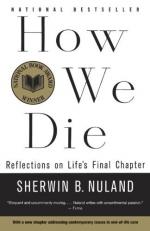
|
| Name: _________________________ | Period: ___________________ |
This test consists of 15 multiple choice questions and 5 short answer questions.
Multiple Choice Questions
1. Where was Irv Lipsiner when he suffered from complete cardiac heart failure, according to the author in Chapter 1?
(a) A hiking trail.
(b) At his office.
(c) A tennis court.
(d) In his home.
2. What word used in Chapter 4 refers to a serious loss of global cognitive ability in a previously unimpaired person, beyond what might be expected from normal aging?
(a) Aphasia.
(b) Dementia.
(c) Obtundation.
(d) Metastasis.
3. What Latin term does the author use to describe the “art of dying” in the Introduction?
(a) Manibus date liliaplenis.
(b) Sub divo.
(c) Facfortiaetpatere.
(d) Arsmoriendi.
4. According to the author in Chapter 4, whereas a young person might have been able to fight off or change the course of illness, the elderly are attacked when the body's parts-replacement process is what?
(a) In overdrive.
(b) At its limit.
(c) No longer functioning.
(d) At its weakest.
5. How old was Katie Mason when she died?
(a) 12.
(b) 4.
(c) 9.
(d) 17.
6. What is the motto of the U.S. Department of Health and Human Services?
(a) “Improving the health, safety, and well-being of America.”
(b) “Looking after America’s Health.”
(c) “Looking after the sick and injured.”
(d) “Liberty, Health, and Freedom.”
7. At what age had Irv Lipsiner suffered a small heart attack, according to the author in Chapter 1?
(a) 64.
(b) 39.
(c) 47.
(d) 78.
8. The electric energy that stimulates the heart occurs where?
(a) The atria.
(b) The sinoatrial node.
(c) The ventricles.
(d) The atrioventricular node.
9. While in the midst of doing his admission paperwork, Dr. Nuland observed James McCarty begin to do what, according to the author in Chapter 1?
(a) Sweat and cry.
(b) Tap his feet rapidly.
(c) Convulse and shout.
(d) Scratch his arms intensely.
10. Dr. Nuland relates that cardiac events are what, if discovered soon enough in Chapter 1?
(a) “Eminently treatable.”
(b) “Officially treatable.”
(c) “Physically treatable.”
(d) “Technically treatable.”
11. The author claims in the Introduction that “[t]he good death has become” what?
(a) “A myth.”
(b) “A lottery.”
(c) “A treasure.”
(d) “A wish.”
12. In examining the “Near-Death Experience” in Chapter 6, Dr. Nuland presents statistics from the case studies of what psychologist?
(a) Dmitri Ivanovsky.
(b) William Caxton.
(c) Dr. Kenneth Ring.
(d) G.J. Walker Smith, M.D.
13. What word from Chapter 6 refers to the fatal process of blood loss, to a degree sufficient to cause death?
(a) Exsanguination.
(b) Dementia.
(c) Metastasis.
(d) Asphyxia.
14. Where do Sherwin B. Nuland, M.D. and his family currently live, according to the Introduction?
(a) Augusta, Maine.
(b) Providence, Rhode Island.
(c) Hamden, Connecticut.
(d) Utica, New York.
15. How old was the author when his mother died of cancer?
(a) 11.
(b) 19.
(c) 3.
(d) 7.
Short Answer Questions
1. What refers to the process by which the ability to grow new cells or perform exchanges in muscle, cells, or molecules becomes impossible?
2. What is described by the author in Chapter 5 as a physician who will investigate a disease by evaluating its origins and symptoms?
3. What is the first of the seven most common causes of death for 85% of the elderly population, as discussed in Chapter 4?
4. How did Katie Mason die, according to the author in Chapter 6?
5. What term from Chapter 6 refers to something pertaining to or symptomatic of agony, especially paroxysmal distress, as the death throes?
|
This section contains 520 words (approx. 2 pages at 300 words per page) |

|




